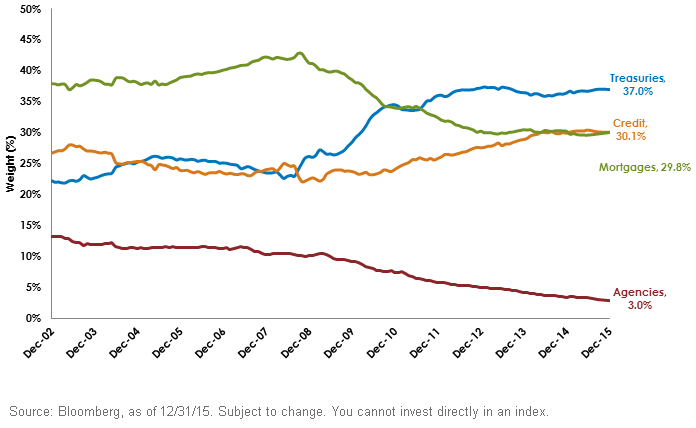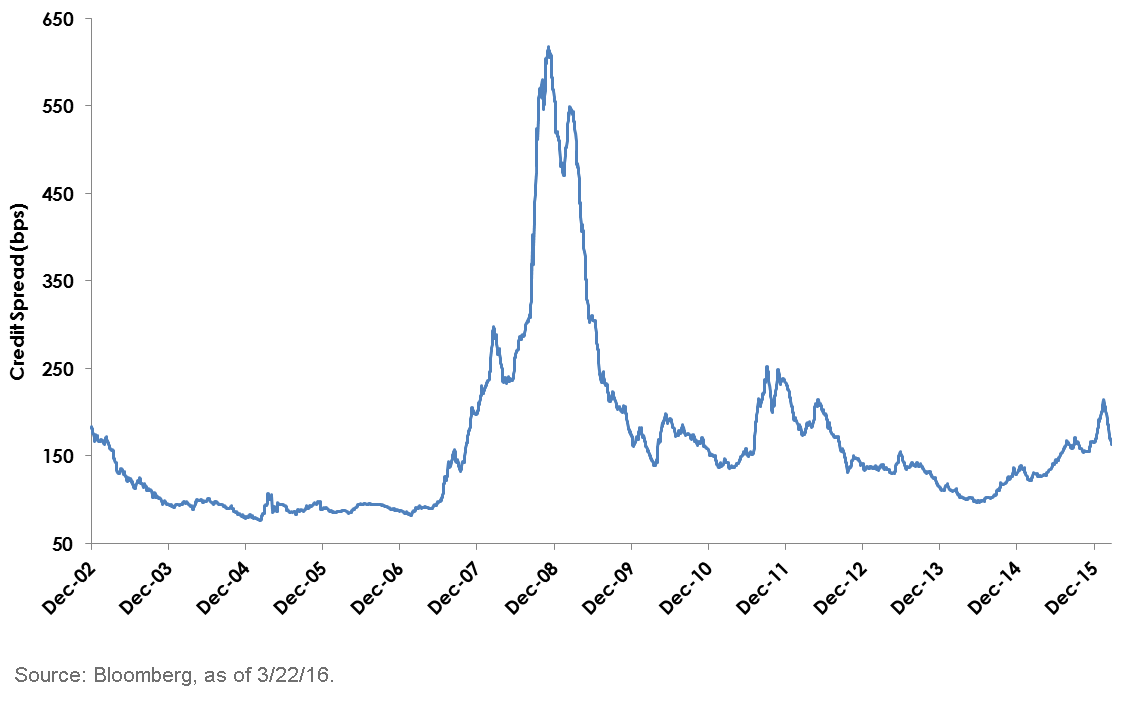Top Five Reasons to Enhance Your Agg Position


 #2: Credit Is Inexpensive
Over the last several months, as concerns about the health of the global economy have increased, credit spreads have widened to levels not seen since 2011. In our view, we do not believe that a recession in the U.S. is likely to occur in the next 12–18 months. As a result, investors should consider increasing allocations to U.S. investment-grade corporates in order to enhance yield and potentially benefit from tightening credit spreads. Compared to the Agg, the Barclays U.S. Aggregate Enhanced Yield Index is 20% over-weight credit and nearly 20% under-weight Treasuries.2
Barclays U.S. Corporate Index: Credit Spread (basis points), 12/31/2008−3/22/2016
#2: Credit Is Inexpensive
Over the last several months, as concerns about the health of the global economy have increased, credit spreads have widened to levels not seen since 2011. In our view, we do not believe that a recession in the U.S. is likely to occur in the next 12–18 months. As a result, investors should consider increasing allocations to U.S. investment-grade corporates in order to enhance yield and potentially benefit from tightening credit spreads. Compared to the Agg, the Barclays U.S. Aggregate Enhanced Yield Index is 20% over-weight credit and nearly 20% under-weight Treasuries.2
Barclays U.S. Corporate Index: Credit Spread (basis points), 12/31/2008−3/22/2016
 #3: Rules-Based Rebalancing Lowers Risk of Style Drift
Oftentimes, many active managers will purchase securities not included in their performance benchmark in order to enhance returns. While this is a commonly accepted approach in the bond market, should this necessarily count as generating alpha? To some, this approach is akin to a large-capitalization (cap) equity manager buying small-cap stocks to boost returns. It’s great when it leads to outperformance, but it can complicate the risk management process for asset allocators managing a number of exposures.
Our approach starts with the same investable universe as the Agg but then seeks to reweight securities based on a set of constraints in order to enhance income.
#4: High Correlation with Greater Income Potential
Since July 2015, the Enhanced Yield Index has had a correlation of 0.96 with the Agg.3 While the enhanced yield strategy has a modestly higher correlation to investment-grade corporate bond indexes, it maintains a modestly negative correlation with equity indexes such as the S&P 500 Index. In our view, with interest rates still low by historical standards, the value of an intermediate bond strategy that exhibits a strongly negative correlation to the S&P 500 is diminished. The positive performance generated by the bond portfolio during equity sell-offs is unlikely to be sufficient to meaningfully dampen the volatility of a traditional 60% equity/40% fixed income portfolio.
#5: Risk-Adjusted Returns: Greater Income Potential Despite Modest Increase in Duration
The enhanced yield strategy currently increases yield by 68 basis points (3.06% vs. 2.38%), while increasing duration by 0.7 years (6.24 vs. 5.54).4 In the current “lower for longer” environment, we believe credit will be a primary determinant of total returns as spreads ultimately tighten from current elevated levels. In our view, this income-for-interest rate risk trade-off appears favorable, given the likely drivers of return in the market.
1Source: Barclays, as of 3/22/16.
2Source: Barclays, as of 3/22/16. Subject to change.
3Sources: WisdomTree, Bloomberg, as of 2/29/16.
4Source: Barclays, as of 3/22/16.
#3: Rules-Based Rebalancing Lowers Risk of Style Drift
Oftentimes, many active managers will purchase securities not included in their performance benchmark in order to enhance returns. While this is a commonly accepted approach in the bond market, should this necessarily count as generating alpha? To some, this approach is akin to a large-capitalization (cap) equity manager buying small-cap stocks to boost returns. It’s great when it leads to outperformance, but it can complicate the risk management process for asset allocators managing a number of exposures.
Our approach starts with the same investable universe as the Agg but then seeks to reweight securities based on a set of constraints in order to enhance income.
#4: High Correlation with Greater Income Potential
Since July 2015, the Enhanced Yield Index has had a correlation of 0.96 with the Agg.3 While the enhanced yield strategy has a modestly higher correlation to investment-grade corporate bond indexes, it maintains a modestly negative correlation with equity indexes such as the S&P 500 Index. In our view, with interest rates still low by historical standards, the value of an intermediate bond strategy that exhibits a strongly negative correlation to the S&P 500 is diminished. The positive performance generated by the bond portfolio during equity sell-offs is unlikely to be sufficient to meaningfully dampen the volatility of a traditional 60% equity/40% fixed income portfolio.
#5: Risk-Adjusted Returns: Greater Income Potential Despite Modest Increase in Duration
The enhanced yield strategy currently increases yield by 68 basis points (3.06% vs. 2.38%), while increasing duration by 0.7 years (6.24 vs. 5.54).4 In the current “lower for longer” environment, we believe credit will be a primary determinant of total returns as spreads ultimately tighten from current elevated levels. In our view, this income-for-interest rate risk trade-off appears favorable, given the likely drivers of return in the market.
1Source: Barclays, as of 3/22/16.
2Source: Barclays, as of 3/22/16. Subject to change.
3Sources: WisdomTree, Bloomberg, as of 2/29/16.
4Source: Barclays, as of 3/22/16.
Important Risks Related to this Article
Fixed income investments are subject to interest rate risk; their value will normally decline as interest rates rise. In addition, when interest rates fall, income may decline. Fixed income investments are also subject to credit risk, the risk that the issuer of a bond will fail to pay interest and principal in a timely manner or that negative perceptions of the issuer’s ability to make such payments will cause the price of that bond to decline.


